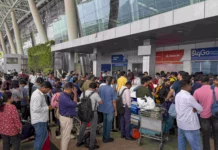 Gateway to four famous pilgrimages of India
Gateway to four famous pilgrimages of India
Haridwar is the gateway to the four pilgrimages Char Dham Yatra of Uttarakhand (Gangotri, Yamunotri, Badrinath and Kedarnath). Haridwar is an important pilgrimage city and municipality in the Haridwar District of Uttarakhand, India. The River Ganges, after flowing for 253 kilometers (157 miles) from its source at Gaumukh at the edge of the Gangotri Glacier, enters the Indo-Gangetic Plains of North India for the first time at Haridwar, which gave the city its ancient name, Gangadwára.
It’s also the starting point on the journey to the sacred sources of rivers Ganga and the Yamuna. According to legend, Prince Bhagirath performed penance here to salvage the souls of his ancestors who had perished due to sage Kapil’s curse. The penance was answered and the river Ganga trickled forth from Lord Shiva’s locks and its bountiful water revived the sons of King Sagara. In the tradition of Bhagirath, devout Hindus stand in the sacred waters here, praying for salvation of their ancestors.
Haridwar is regarded as one of the seven holiest places to Hindus. According to the Samudra Manthan, Haridwar along with Ujjain, Nasik and Allahabad is one of four sites where drops of Amrit, the elixir of immortality, accidentally spilled over from the pitcher while being carried by the celestial bird Garuda. This is manifested in the Kumbha Mela being celebrated every three years in one of the four places, and thus every 12 years in Haridwar.
Amidst the Kumbha Mela, millions of pilgrims, devotees, and tourists congregate in Haridwar to perform ritualistic bathing on the banks of the river Ganges to wash away their sins and to attain Moksha. Brahma Kund, the spot where the Amrit fell, is located at Har ki Pauri (literally, “footsteps of the Lord”) and is considered to be the most sacred ghat of Haridwar.
Haridwar is the headquarters and the largest city of the district. Today, the Haridwar city is developing beyond its religious importance, with the fast developing industrial estate of State Infrastructure and Industrial Development Corporation (SIDCUL), and the close by township of Bharat Heavy Electricals Limited in Ranipur, Uttarakhand, as well as its affiliated ancillaries.
Etymology
In Sanskrit, Haridwar stands for Dwara of Hari or Gateway to God, where ‘Hari’ means God and ‘Dwar’ means Gate. In ancient times, the city was referred to as Gangadwára, the place where the Ganges descends to the plains.
Haridwar is a vegetarian city by law, as well as an alcohol-free city.
Places to Visit
Har Ki Pauri
This sacred Ghat was constructed by King Vikramaditya (1st century BC) in memory of his brother Bhrithari. It is believed that Bhrithari came to Haridwar and meditated on the banks of the holy Ganges. When he died, his brother constructed a Ghat in his name, which later came to be known as Har-Ki-Pauri. The most sacred ghat within Har-ki-Pauri is Brahmakund. The evening prayer (Aarti) at dusk offered to Goddess Ganga at Har-Ki-Pauri (steps of God Hara or Shiva) is an enchanting experience for any visitor.
A spectacle of sound and color is seen when, after the ceremony, pilgrims float diyas (floral floats with lamps) and incense on the river, commemorating their deceased ancestors. Thousands of people from all round the world make a point to attend this prayer on their visit to Haridwar. A majority of present ghats were largely developed in the 1800s.
Chandi Devi Temple
The temple is dedicated to Goddess Chandi, who sits atop the ‘Neel Parvat’ on the eastern bank of river Ganges. It was constructed in 1929 A.D. by the King of Kashmir, Suchat Singh. Skanda Purana mentions a legend in which Chanda-Munda, the Army Chief of a local Demon Kings Shumbh and Nishumbha were killed by goddess Chandi here, after which the place got the name Chandi Devi. It is believed that the main statue was established by Adi Shankracharya in 8th century A.D. The temple is a three km trek from Chandighat and can also be reached through a ropeway which takes one up in just 5-10 minutes.
Mansa Devi Temple
Situated at the top of Bilwa Parwat, the temple of Goddess Mansa Devi, literally meaning the Goddess who fulfills desires (Mansa), is a popular tourist destination, especially because of the cable cars, which offer a picturesque view of the entire city. The main temple houses two idols of the Goddess, one with three mouths and five arms, while the other one has eight arms. Visitors to Mansa Devi Temple have a number of options for getting to the temple. There are regular taxis, auto rickshaws and cabs available from Haridwar to Mansa Devi. To reach the hilltop, one can use the ropeway-cable car. If looking for a light dose of adventure, one can choose to trek up to the temple.
Maya Devi Temple
Dating to the 11th century, this ancient temple of Maya Devi, the Adhisthatri deity of Hardwar, is considered one of the Siddhapethas and is said to be the place where the heart and navel of Goddess Sati had fallen. It is one of few ancient temples still standing in Haridwar, along with Narayani Shila temple and Bhairav Temple.
Kankhal
The ancient temple of Daksha Mahadev also known as Daksheswara Mahadev Temple, is situated in the south Kankhal town. According to Hindu texts, King Daksha Prajapati, father of Dakshayani, Lord Shiva’s first wife, performed a yagna, to which he deliberately did not invite Lord Shiva.
When he arrived uninvited, he was further insulted by the king, seeing which Sati felt infuriated and self-immolated herself in the yagna kund. King Daksha was later killed by the demon Virabhadra, born out of Shiva’s anger. Later the king was brought to life and given a goat’s head by Shiva. Daksha Mahadev temple is a tribute to this legend.
Sati Kund, another well-known mythological heritage worth a visit is situated in Kankhal. Legend has it that Sati immolated herself in this kund.
Piran Kaliyar
Built by Ibrahim Lodhi, a ruler of Delhi, this ‘Dargah’ of Hazrat Alauddin Sabir Kaliyari, a 13th century, Sufi Saint of Chishti Order (also known as Sarkar Sabir Pak), in Kaliyar village, 7 km. from Roorkee, is a living example of religious harmony in India. It is visited by devotees from all over the world during the annual ‘Urs’ festival, which is celebrated from
1st day of sighting the moon to 16th day of Rabeeull month Islamic calendar.
Best time to visit
Haridwar is a picturesque destination affording enchanting views throughout the year.
The right time to visit would be February, March, August – October.
In the summer months between March and June, the days get hot but the nights remain pleasant. One way to cool off is by taking a dip in the holy Ganges.
In July there is a festival called Savan where thousands of people flock to Haridwar. Major roads are blocked and hotels are crowded. It is better to avoid traveling to Haridwar during that time.
Haridwar hosts many religious festivals as a place of religious significance. Ramanavami (March-April), Buddha Poornima (May), Kanwar Mela (July), Karthika Poornima (November) and Diwali (October) are some festivals celebrated here with much festivities. It is estimated that nearly 3 million people attend Kanwar Mela in July.
How to reach
By Road
The National Highway no. 45 connects Haridwar to other cities of the state as well as other cities. The road connecting Haridwar to Delhi ensures an extremely comfortable travel.
National Highway 58, between Delhi and Mana Pass passes through Haridwar connecting it with Ghaziabad, Meerut, Muzzafarnagar, Roorkee and Badrinath and National Highway 74 originating from Haridwar connects it with Kashipur, Kichha, Nagina, Pilibhit and Bareilly.
By Rail
One of the main railheads of Northern Railways, Haridwar Junction is connected by meter gauge and broad gauge lines. The nearby station of Rishikesh is connected to Haridwar on a branch line. Towards west, the major railhead is at Saharanpur (80 km) and going north, the major railhead is at Dehradun (66 km).
By Air
The nearest domestic airport is Jolly Grant Airport in Dehradun which is located 35 km from Haridwar. Indira Gandhi International Airport in New Delhi is the nearest International Airport.






